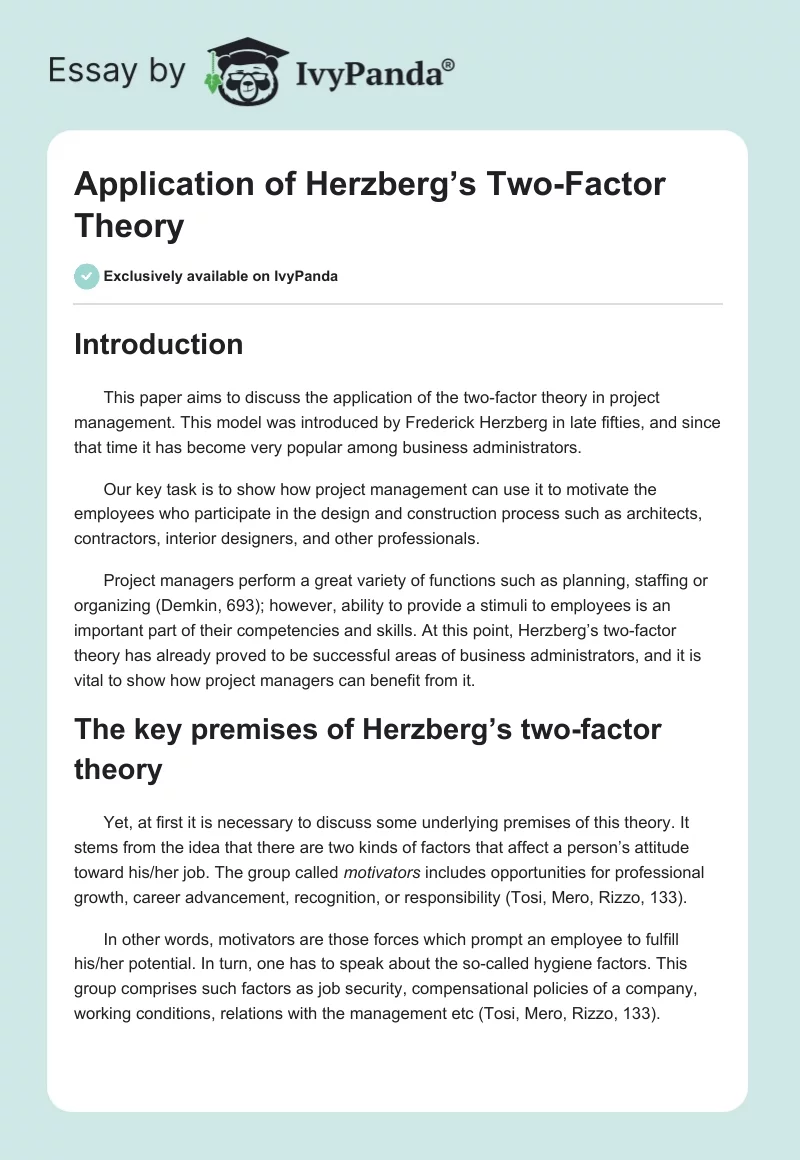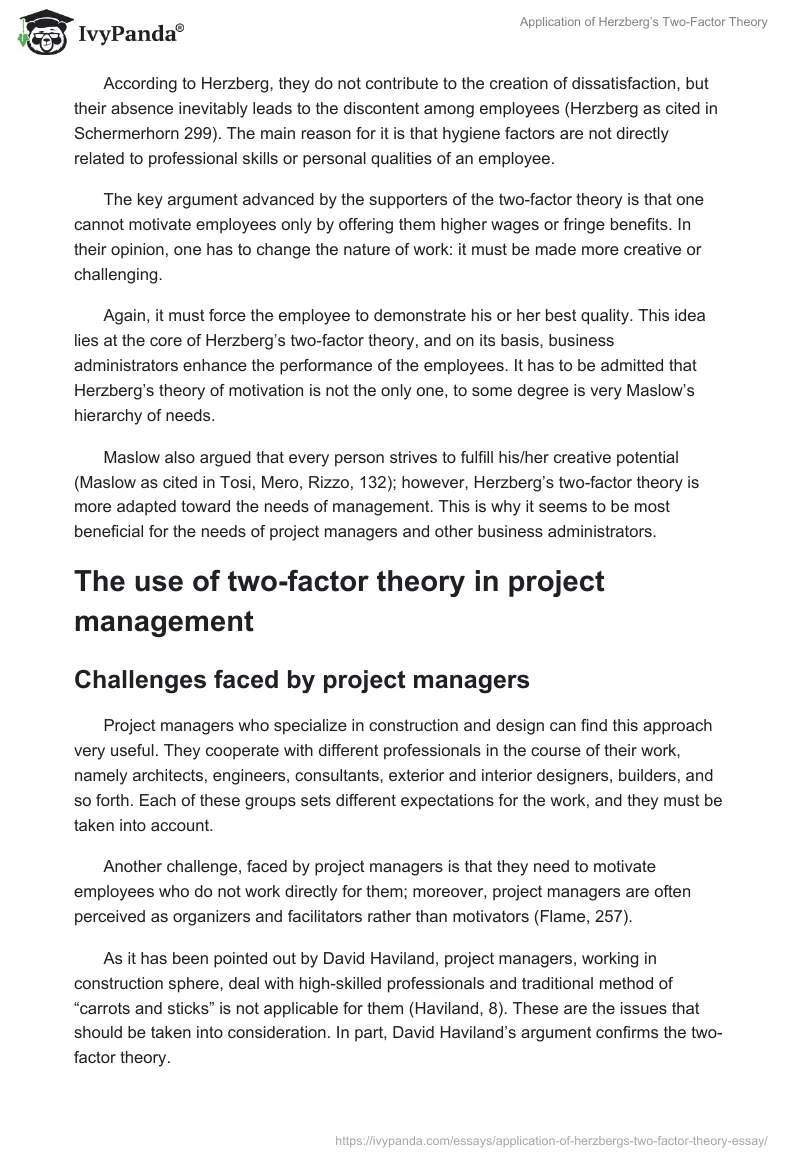Introduction
This paper aims to discuss the application of the two-factor theory in project management. This model was introduced by Frederick Herzberg in late fifties, and since that time it has become very popular among business administrators.
Our key task is to show how project management can use it to motivate the employees who participate in the design and construction process such as architects, contractors, interior designers, and other professionals.
Project managers perform a great variety of functions such as planning, staffing or organizing (Demkin, 693); however, ability to provide a stimuli to employees is an important part of their competencies and skills. At this point, Herzberg’s two-factor theory has already proved to be successful areas of business administrators, and it is vital to show how project managers can benefit from it.
The key premises of Herzberg’s two-factor theory
Yet, at first it is necessary to discuss some underlying premises of this theory. It stems from the idea that there are two kinds of factors that affect a person’s attitude toward his/her job. The group called motivators includes opportunities for professional growth, career advancement, recognition, or responsibility (Tosi, Mero, Rizzo, 133).
In other words, motivators are those forces which prompt an employee to fulfill his/her potential. In turn, one has to speak about the so-called hygiene factors. This group comprises such factors as job security, compensational policies of a company, working conditions, relations with the management etc (Tosi, Mero, Rizzo, 133).
According to Herzberg, they do not contribute to the creation of dissatisfaction, but their absence inevitably leads to the discontent among employees (Herzberg as cited in Schermerhorn 299). The main reason for it is that hygiene factors are not directly related to professional skills or personal qualities of an employee.
The key argument advanced by the supporters of the two-factor theory is that one cannot motivate employees only by offering them higher wages or fringe benefits. In their opinion, one has to change the nature of work: it must be made more creative or challenging.
Again, it must force the employee to demonstrate his or her best quality. This idea lies at the core of Herzberg’s two-factor theory, and on its basis, business administrators enhance the performance of the employees. It has to be admitted that Herzberg’s theory of motivation is not the only one, to some degree is very Maslow’s hierarchy of needs.
Maslow also argued that every person strives to fulfill his/her creative potential (Maslow as cited in Tosi, Mero, Rizzo, 132); however, Herzberg’s two-factor theory is more adapted toward the needs of management. This is why it seems to be most beneficial for the needs of project managers and other business administrators.
The use of two-factor theory in project management
Challenges faced by project managers
Project managers who specialize in construction and design can find this approach very useful. They cooperate with different professionals in the course of their work, namely architects, engineers, consultants, exterior and interior designers, builders, and so forth. Each of these groups sets different expectations for the work, and they must be taken into account.
Another challenge, faced by project managers is that they need to motivate employees who do not work directly for them; moreover, project managers are often perceived as organizers and facilitators rather than motivators (Flame, 257).
As it has been pointed out by David Haviland, project managers, working in construction sphere, deal with high-skilled professionals and traditional method of “carrots and sticks” is not applicable for them (Haviland, 8). These are the issues that should be taken into consideration. In part, David Haviland’s argument confirms the two-factor theory.
Motivators
At this point, we need to explain how this model can be applied by project managers. For instance, one can take architects; these professional have to possess a great of skills, including technical competence, in-depth understanding of the construction process, profound knowledge of modern technologies, etc.
However, the key component is creativity, and this component seems to be the most rewarding part of being an architect. This is why a project management must provide this person with opportunities for demonstrating his creative talent. It can be done in several ways: on the one hand, the project manager should relax supervision of these employees: they must understand that the project manager puts trust in them.
Secondly, the project should not restrict their creative capacity. Certainly, an architect has to adhere to a certain style and also take into consideration the needs of people who will occupy the building but no one should be telling architects how exactly they must design a building.
In this way, one would greatly diminish their job satisfaction. Similar strategies can be applied to exterior and interior designers. Overall, these people attach the highest importance to creativity, and project managers must make sure that they have such an opportunity.
Furthermore, project managers work directly with many contractors and consultants. If we are speaking about motivators, we need to single out such factors as empowerment and recognition. These professionals need to receive a certain degree of autonomy and especially ability to make independent decisions. Moreover, one should not overlook the role of recognition.
For instance, while assessing the performance of the workers, the project manager should record every contribution made by consultants, engineers, contractors. If one of them has made recommendations that can facilitate the process of construction, the project manager should definitely recognize this contribution. Those employees, who continuously contribute to the success of the project, should be promoted.
Without recognition and advancement, they people may think that the manager does not value them, and they will gradually become dissatisfied with their work. As we have demonstrated, those people, who take part in construction and design projects, tend to set different expectations for their jobs.
For some of them, creativity is of the highest priority, while others may pay more attention to recognition and advancement. In some cases, this difference can be explained by the peculiarities of the job, itself; yet, very often expectations depend on the personnel traits of an employee.
It is a duty of a project manager to understand what exactly people expect from their job; otherwise, he or she will find it very difficult to motivate them.
Hygiene factors
Nonetheless, one should not disregard the importance of hygiene factors such as salary, job security, work condition, managerial policies of the company, etc. The project manager has to make sure that every person receives adequate compensation for his/her work.
Secondly, the project manager should make sure that each member of the personnel does not feel insecure about his or her position in the company since this is one of those factors which lead to discontent and even force employees to search for a different job.
Finally, the project manager must ensure that each consultant, engineer, contractor is occupied with a task that directly matches his/her skills since this is an essential part of work conditions. As a rule, hygiene factors do not provide a powerful stimulus to the employees but they are essential for avoiding employee dissatisfaction.
Conclusion
This discussion shows that two-factor theory advanced by Frederick Herzberg can be of great use to project managers who are working on construction and design projects. Their major task is to improve the first group of factors which are usually called motivators.
The thing is that a project manager must know exactly which factor provides the most powerful stimulus to the employees. In some cases, it can be the opportunity to demonstrate one’s creative skills without restrictions, while some employees can value recognition and advancement. Hygiene factors seem to have a similar effect on the workers satisfaction or dissatisfaction.
Works Cited
Demkin. J. The architect’s handbook of professional practice. NY: John Wiley and Sons, 2008. Print.
Flame. J. The new project management: tools for an age of rapid change, complexity, and other business realities. London: John Wiley and Sons, 2002. Print.
Haviland. David. Managing Archtectural Projects: The Effective Project Manager. American Institute of Architects. 1985.
Levi. Sidney. Project Management in Construction. Cambridge: McGraw-Hill Professional, 2006. Print.
Schermerhorn John. Exploring Management. New Jersey. John Wiley and Sons, 2009. Print.
Tosi. Henry. Mero Neal, and Rizzo Mero. Managing organizational behavior. NY Wiley-Blackwell, 2000. Print
Waldrep. Lee. Becoming an Architect: A Guide to Careers in Design. Lomdon John Wiley and Sons, 2009. Print.


